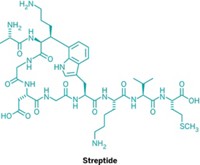Advertisement
Grab your lab coat. Let's get started
Welcome!
Welcome!
Create an account below to get 6 C&EN articles per month, receive newsletters and more - all free.
It seems this is your first time logging in online. Please enter the following information to continue.
As an ACS member you automatically get access to this site. All we need is few more details to create your reading experience.
Not you? Sign in with a different account.
Not you? Sign in with a different account.
ERROR 1
ERROR 1
ERROR 2
ERROR 2
ERROR 2
ERROR 2
ERROR 2
Password and Confirm password must match.
If you have an ACS member number, please enter it here so we can link this account to your membership. (optional)
ERROR 2
ACS values your privacy. By submitting your information, you are gaining access to C&EN and subscribing to our weekly newsletter. We use the information you provide to make your reading experience better, and we will never sell your data to third party members.
Materials
Hybrid Sugar-peptide Copolymers
Novel class of biomaterials is prepared from natural sugars and peptides
by Michael Freemantle
September 21, 2005
A new design concept for the synthesis of biomaterials from carbohydrates and peptides has been revealed by chemists at the University of California, Irvine (Angew. Chem. Int. Ed., published online Sept. 15, dx.doi.org/10.1002/anie.200501944).

The design concept “uses a modular approach to construct saccharide-peptide hybrid copolymers as highly functional biomaterials,” explains associate professor of chemistry Zhibin Guan, who led the group. “We created the materials from two of the most abundant types of natural building blocks—sugars and peptides.”
Guan’s team used an approach known as interfacial polymerization to prepare a series of three galactaro-oligolysine hybrid copolymers from a galactose-derived monomer and three oligolysine peptide monomers: dilysine, trilysine, and tetralysine. The monosaccharide and oligopeptide building blocks are linked together in alternating sequence into one polymer chain.
“The monomers do not have to be produced by complicated methods,” he says. “The modular synthesis allows for quick access to a diverse family of biomaterials that can be screened for chemical, biological, and mechanical properties.
“The rich functionalities on saccharides and peptides allow for the design of biomaterials that are interactive and/or instructive in biological applications,” Guan continues. He observes that such materials are critically needed for modern biomedical applications, including drug and gene delivery, DNA and protein microarrays, polymer therapeutics, and tissue engineering.
“We showed that the initial series of hybrid copolymers are biodegradable, nonimmunogenic, and efficient for transferring plasmid DNA into cell nuclei,” Guan says. “Whereas well-known gene transporters such as polylysine, made exclusively of lysine building blocks, are often quite poisonous, our new materials exhibit minimal cytotoxic effects at high concentrations. It is quite amazing that incorporation of saccharide units into a polylysine backbone can reduce cytotoxicity to such a great extent.”
The group is currently working on the development of new and more efficient synthesis routes and the design of hybrid copolymers with the desired structures and properties needed for drug and gene delivery, as well as tissue engineering.
“One specific goal is to develop new biomaterials that can control the differentiation of embryonic stem cells,” Guan says.







Join the conversation
Contact the reporter
Submit a Letter to the Editor for publication
Engage with us on Twitter